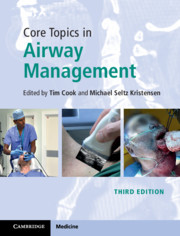Book contents
- Core Topics in Airway Management
- Core Topics in Airway Management
- Copyright page
- Contents
- Contributors
- Foreword
- Preface to the Third Edition
- Section 1 Airway Management: Background and Techniques
- Section 2 Airway Management: Clinical Settings and Subspecialties
- Chapter 22 The Airway in Obstetrics
- Chapter 23 The Paediatric Airway
- Chapter 24 Airway Management in Obesity
- Chapter 25 Maxillofacial and Dental Surgery
- Chapter 26 Ear, Nose and Throat Surgery: Airway Management
- Chapter 27 Lung Separation
- Chapter 28 Airway Management in the Critically Ill
- Chapter 29 The Patient with a Tracheostomy
- Chapter 30 Pre-hospital and Trauma Airway Management
- Chapter 31 Airway Management during CPR
- Chapter 32 The Bloody and Bleeding Airway
- Chapter 33 The Airway in Anaesthesia for Transoral Robotic Surgery
- Section 3 Airway Management: Organisation
- Index
- References
Chapter 33 - The Airway in Anaesthesia for Transoral Robotic Surgery
from Section 2 - Airway Management: Clinical Settings and Subspecialties
Published online by Cambridge University Press: 03 October 2020
- Core Topics in Airway Management
- Core Topics in Airway Management
- Copyright page
- Contents
- Contributors
- Foreword
- Preface to the Third Edition
- Section 1 Airway Management: Background and Techniques
- Section 2 Airway Management: Clinical Settings and Subspecialties
- Chapter 22 The Airway in Obstetrics
- Chapter 23 The Paediatric Airway
- Chapter 24 Airway Management in Obesity
- Chapter 25 Maxillofacial and Dental Surgery
- Chapter 26 Ear, Nose and Throat Surgery: Airway Management
- Chapter 27 Lung Separation
- Chapter 28 Airway Management in the Critically Ill
- Chapter 29 The Patient with a Tracheostomy
- Chapter 30 Pre-hospital and Trauma Airway Management
- Chapter 31 Airway Management during CPR
- Chapter 32 The Bloody and Bleeding Airway
- Chapter 33 The Airway in Anaesthesia for Transoral Robotic Surgery
- Section 3 Airway Management: Organisation
- Index
- References
Summary
Transoral robotic surgery (TORS) allows resection of otherwise inaccessible pathology. It generates unique challenges to the airway management of the patient due to the shared location of the anaesthetist and the surgeon’s equipment. A close cooperation between the anaesthetic and surgical team is required, for the safe handling of the airway. The anaesthetist needs to be able to employ a variety of airway manoeuvres in order to ensure the airway patency throughout the perioperative and post-operative period. The airway of the TORS patient is characterised by its dynamic nature, as it changes due to the surgery, swelling and bleeding.
Keywords
- Type
- Chapter
- Information
- Core Topics in Airway Management , pp. 290 - 292Publisher: Cambridge University PressPrint publication year: 2020



